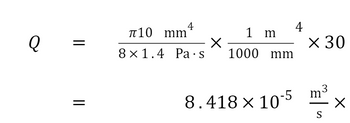we also considered pressure driven flow of an incompressible Newtonian fluid (INF) through the annular gap between two horizontal coaxial cylinders as shown in the figure below: PO>PL a. Q= 12R₁ 2RO The correct equation was: TRAP (R₂)* 8μ L v₂(r) = Using this piece of information, calculate Vav (m/s) and then the Reynolds number for the following conditions: Glycerin at 20 °C, a very viscous fluid (1.4 Pa*s), is the INF in the annular space R₂ = 10 mm R₁ = 2 mm AP/L = 30 kPa/m Based on your calculation of the Reynolds number, what can you conclude about the existence of laminar flow conditions? 4μ . In b. The axial velocity profile v.(r) for the system described above is as follows: 1 ΔΡ R²-R² r ∙In in (Ro/R₂) Ro R²-² + Equation 7.98 from Vlachopoulos' book Using Excel (or another suitable software), plot the axial velocity profile for the conditions given in part a). In order to match the physical nature of the system, plot the axial velocity (v:(r)) on the x-axis and the radial distance (r) on the y-axis. The range of y values should be from 0 to +R₂-be VERY careful about what happens in the range of y values from 0 to +R₁.
we also considered pressure driven flow of an incompressible Newtonian fluid (INF) through the annular gap between two horizontal coaxial cylinders as shown in the figure below: PO>PL a. Q= 12R₁ 2RO The correct equation was: TRAP (R₂)* 8μ L v₂(r) = Using this piece of information, calculate Vav (m/s) and then the Reynolds number for the following conditions: Glycerin at 20 °C, a very viscous fluid (1.4 Pa*s), is the INF in the annular space R₂ = 10 mm R₁ = 2 mm AP/L = 30 kPa/m Based on your calculation of the Reynolds number, what can you conclude about the existence of laminar flow conditions? 4μ . In b. The axial velocity profile v.(r) for the system described above is as follows: 1 ΔΡ R²-R² r ∙In in (Ro/R₂) Ro R²-² + Equation 7.98 from Vlachopoulos' book Using Excel (or another suitable software), plot the axial velocity profile for the conditions given in part a). In order to match the physical nature of the system, plot the axial velocity (v:(r)) on the x-axis and the radial distance (r) on the y-axis. The range of y values should be from 0 to +R₂-be VERY careful about what happens in the range of y values from 0 to +R₁.
Introduction to Chemical Engineering Thermodynamics
8th Edition
ISBN:9781259696527
Author:J.M. Smith Termodinamica en ingenieria quimica, Hendrick C Van Ness, Michael Abbott, Mark Swihart
Publisher:J.M. Smith Termodinamica en ingenieria quimica, Hendrick C Van Ness, Michael Abbott, Mark Swihart
Chapter1: Introduction
Section: Chapter Questions
Problem 1.1P
Related questions
Question

Transcribed Image Text:we also considered pressure driven flow of an incompressible Newtonian fluid (INF) through the annular
gap between two horizontal coaxial cylinders as shown in the figure below:
PO>PL
co
TRAP
8μ L
2R₁
2R₁ 2RO
(R.)
Using this piece of information, calculate Vav (m/s) and then the Reynolds number for the following
conditions:
The correct equation was:
1-)
In
v₂(r) =
TO
Glycerin at 20 °C, a very viscous fluid (1.4 Pa*s), is the INF in the annular space
R. = 10 mm
R₁ = 2 mm
AP/L = 30 kPa/m
Based on your calculation of the Reynolds number, what can you conclude about the existence of laminar
flow conditions?
b. The axial velocity profile v.(r) for the system described above is as follows:
1 ΔΡ
4μ L
R² - R² r
Ro
∙In
In
(Ro/R₂)
R² −²+
Equation 7.98 from
Vlachopoulos' book
Using Excel (or another suitable software), plot the axial velocity profile for the conditions given in part a). In
order to match the physical nature of the system, plot the axial velocity (v:(r)) on the x-axis and the radial
distance (r) on the y-axis. The range of y values should be from 0 to +R₂-be VERY careful about what
happens in the range of y values from 0 to +R₁.
Expert Solution
This question has been solved!
Explore an expertly crafted, step-by-step solution for a thorough understanding of key concepts.
This is a popular solution!
Trending now
This is a popular solution!
Step by step
Solved in 8 steps with 3 images

Follow-up Questions
Read through expert solutions to related follow-up questions below.
Follow-up Question
I got 10^(-8) instead of 10^(-5) can someone tell me what I'm doing wrong or if my answer is correct?

Transcribed Image Text:Q
=
||
4
π10 mm
8x1.4 Pa.s
X
1 m
1000 mm
8.418 × 10
4
× 30
m³
3
S
X
Solution
Recommended textbooks for you

Introduction to Chemical Engineering Thermodynami…
Chemical Engineering
ISBN:
9781259696527
Author:
J.M. Smith Termodinamica en ingenieria quimica, Hendrick C Van Ness, Michael Abbott, Mark Swihart
Publisher:
McGraw-Hill Education

Elementary Principles of Chemical Processes, Bind…
Chemical Engineering
ISBN:
9781118431221
Author:
Richard M. Felder, Ronald W. Rousseau, Lisa G. Bullard
Publisher:
WILEY

Elements of Chemical Reaction Engineering (5th Ed…
Chemical Engineering
ISBN:
9780133887518
Author:
H. Scott Fogler
Publisher:
Prentice Hall

Introduction to Chemical Engineering Thermodynami…
Chemical Engineering
ISBN:
9781259696527
Author:
J.M. Smith Termodinamica en ingenieria quimica, Hendrick C Van Ness, Michael Abbott, Mark Swihart
Publisher:
McGraw-Hill Education

Elementary Principles of Chemical Processes, Bind…
Chemical Engineering
ISBN:
9781118431221
Author:
Richard M. Felder, Ronald W. Rousseau, Lisa G. Bullard
Publisher:
WILEY

Elements of Chemical Reaction Engineering (5th Ed…
Chemical Engineering
ISBN:
9780133887518
Author:
H. Scott Fogler
Publisher:
Prentice Hall


Industrial Plastics: Theory and Applications
Chemical Engineering
ISBN:
9781285061238
Author:
Lokensgard, Erik
Publisher:
Delmar Cengage Learning

Unit Operations of Chemical Engineering
Chemical Engineering
ISBN:
9780072848236
Author:
Warren McCabe, Julian C. Smith, Peter Harriott
Publisher:
McGraw-Hill Companies, The